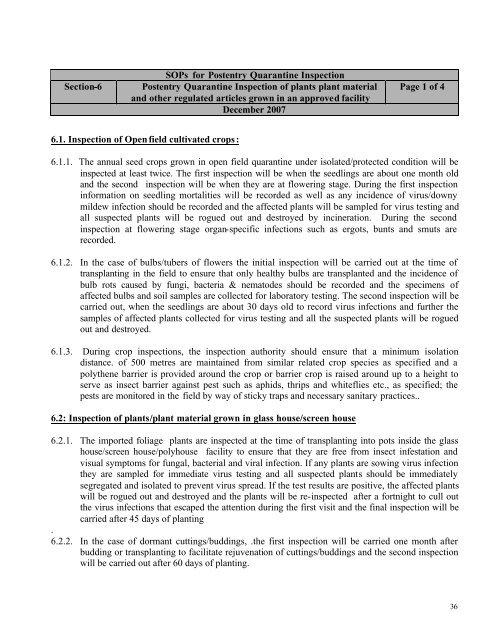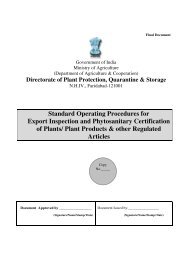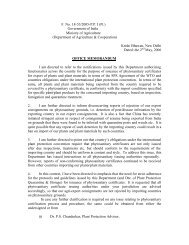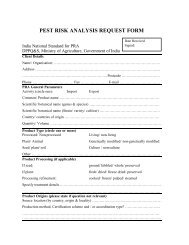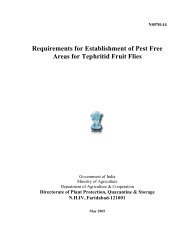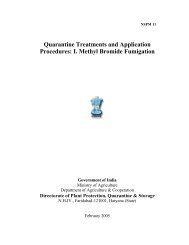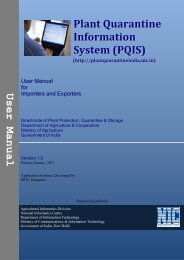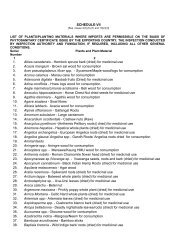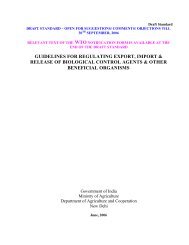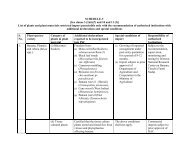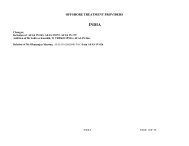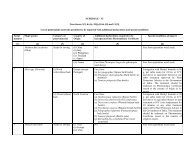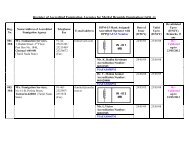SOP for Post Entry Quarantine Inspection - Plant quarantine India
SOP for Post Entry Quarantine Inspection - Plant quarantine India
SOP for Post Entry Quarantine Inspection - Plant quarantine India
You also want an ePaper? Increase the reach of your titles
YUMPU automatically turns print PDFs into web optimized ePapers that Google loves.
Section-6<strong>SOP</strong>s <strong>for</strong> <strong>Post</strong>entry <strong>Quarantine</strong> <strong>Inspection</strong><strong>Post</strong>entry <strong>Quarantine</strong> <strong>Inspection</strong> of plants plant materialand other regulated articles grown in an approved facilityDecember 2007Page 1 of 46.1. <strong>Inspection</strong> of Open field cultivated crops:6.1.1. The annual seed crops grown in open field <strong>quarantine</strong> under isolated/protected condition will beinspected at least twice. The first inspection will be when the seedlings are about one month oldand the second inspection will be when they are at flowering stage. During the first inspectionin<strong>for</strong>mation on seedling mortalities will be recorded as well as any incidence of virus/downymildew infection should be recorded and the affected plants will be sampled <strong>for</strong> virus testing andall suspected plants will be rogued out and destroyed by incineration. During the secondinspection at flowering stage organ-specific infections such as ergots, bunts and smuts arerecorded.6.1.2. In the case of bulbs/tubers of flowers the initial inspection will be carried out at the time oftransplanting in the field to ensure that only healthy bulbs are transplanted and the incidence ofbulb rots caused by fungi, bacteria & nematodes should be recorded and the specimens ofaffected bulbs and soil samples are collected <strong>for</strong> laboratory testing. The second inspection will becarried out, when the seedlings are about 30 days old to record virus infections and further thesamples of affected plants collected <strong>for</strong> virus testing and all the suspected plants will be roguedout and destroyed.6.1.3. During crop inspections, the inspection authority should ensure that a minimum isolationdistance. of 500 metres are maintained from similar related crop species as specified and apolythene barrier is provided around the crop or barrier crop is raised around up to a height toserve as insect barrier against pest such as aphids, thrips and whiteflies etc., as specified; thepests are monitored in the field by way of sticky traps and necessary sanitary practices..6.2: <strong>Inspection</strong> of plants/plant material grown in glass house/screen house6.2.1. The imported foliage plants are inspected at the time of transplanting into pots inside the glasshouse/screen house/polyhouse facility to ensure that they are free from insect infestation andvisual symptoms <strong>for</strong> fungal, bacterial and viral infection. If any plants are sowing virus infectionthey are sampled <strong>for</strong> immediate virus testing and all suspected plants should be immediatelysegregated and isolated to prevent virus spread. If the test results are positive, the affected plantswill be rogued out and destroyed and the plants will be re-inspected after a <strong>for</strong>tnight to cull outthe virus infections that escaped the attention during the first visit and the final inspection will becarried after 45 days of planting.6.2.2. In the case of dormant cuttings/buddings, .the first inspection will be carried one month afterbudding or transplanting to facilitate rejuvenation of cuttings/buddings and the second inspectionwill be carried out after 60 days of planting.36


